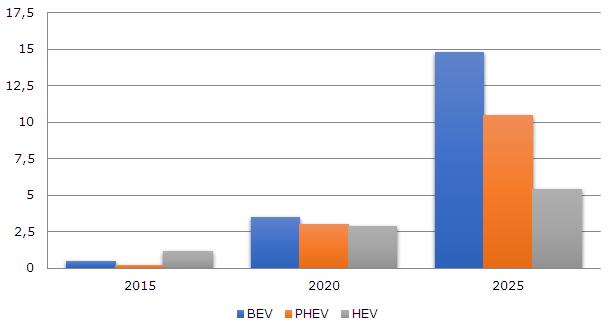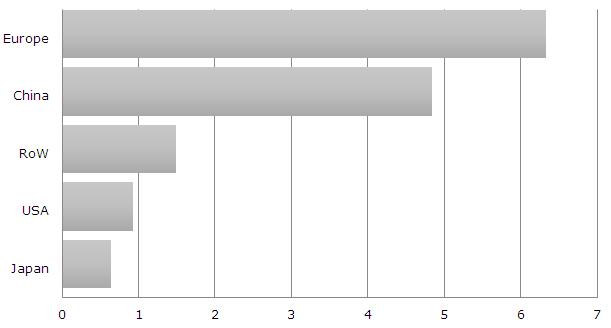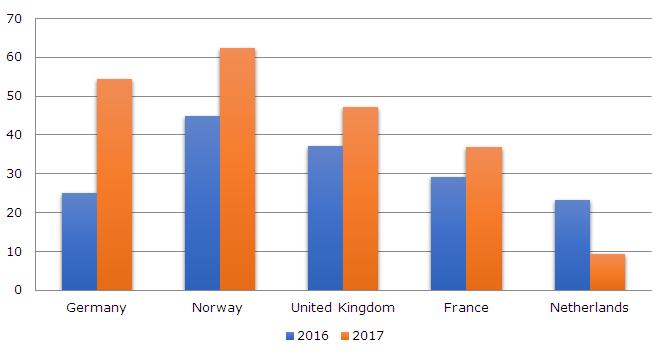Electric Vehicles to See Wider Uptake in Years to Come
14 May 2018 • by Natalie Aster

Following years of promise, electric vehicles (EVs) eventually began to see slow, stable growth early in the 21st century. EVs are deemed to be the vehicles of tomorrow and, with great probability, will make conventional internal combustion energy (ICE) cars obsolete.
The high operating costs of conventional cars have led to a shift of consumers’ interest towards EVs. Furthermore, EVs are nature-friendly, as they do not pollute the air, unlike their conventional counterparts. These factors are considerably driving the world EV sector.
The global EV market is projected to keep on registering an impressive 19.2% CAGR in value terms in the short run. The revenue generated in the sector is likely to increase from USD 83.54 billion as of 2012 to USD 271.67 billion by 2019-end.
Global EV market size in 2012 and 2019 (in billion USD)
High maintenance costs of gasoline-fueled cars have pushed consumers to shift to EVs. The initiatives taken by different governmental agencies to promote EV sales, surging environmental awareness amid consumers, and an expanding vehicle range are some of the key factors responsible for the upswing of the EV market. Furthermore, the enhanced road infrastructure network has supported the EV market growth, with more and more charge points available on the civilian roads.
However, the need to charge EVs very frequently makes them not applicable for long-distance driving, which is significantly affecting the market for EVs in the world arena. Amid the other battery-related challenges to the market growth and development one can name the high purchase costs along with bulk and weight.
Electric Cars to Outpace Other EV Product Categories in Terms of Revenue
Amid the various EV types (e.g., buses and automobiles, electric motorcycles and scooters, etc.), electric cars will continue to grab the lion’s share of the total revenues generated by the global EV industry in the offing. The category of electric bicycles and trucks comes second with respect to revenues. Meanwhile, in volume terms, electric bicycles outpaces the rest of the EV product categories, with this segment also likely to generate the biggest number of units over the forthcoming period.
Production of BEVs to Surpass Other EV Types in Years Ahead
Governments from pole to pole give preference to battery electric vehicles (BEVs) due to zero emission levels by encouraging BEVs’ sales via subsidies and tax remissions. The number of EVs in use worldwide surged to a record high of 2 million globally as of 2016, with that of BEVs standing at above 1.2 million.
Worldwide number of BEVs in use from 2012 to 2016 (in thousands)
The constantly improving charging infrastructure, decreasing recharge time and enhancing government support are poised to push the BEV segment to demonstrate the fastest growth amidst other EV propulsion systems such as plug-in hybrid electric vehicles (PHEVs) and hybrid electric vehicles (HEVs).
The world production of pure BEVs is expected to gain momentum in the offing and amount close to 14.8 million units by 2025. Meantime, the world production of PHEVs is forecast to climb to approximately 10.5 million units by 2025. Worldwide, the production of HEVs is anticipated to gather steam to stand at around 5.4 million units by 2025.
Global production of BEVs, PHEVs and HEVs from 2015 to 2025 (in millions)
Over the next eight years, the overall sales of EVs are poised to increase worldwide, boosted primarily by robust EV adoption (especially in China) and high-level production of the much-awaited Tesla’s Model-3.
Nowadays, BEVs tend to leave PHEVs behind. However, the sales of PHEVs will continue to play an essential role in the uptake of EVs through 2025. After 2025, BEVs are more likely to have a head start on and grab the overwhelming majority of total EV sales. Amid the major reasons for this anticipated shift, one can name the technological sophistication of PHEV platforms, their affordable prices and dual drivetrains, which make BEVs more attractive on a long-run horizon. Only in Japan PHEVs are set to keep on being instrumental following 2030.
China to Maintain Leadership in EV Sales Globally
APAC dominates the EV market and exhibits the highest growth rates. The governments of the region’s major economies, Japan and China, aid grants and other non-monetary benefits like access to licence plate, car-pool lane, and road tax rebates for users of EVs. The extensive and ever-improving charging infrastructure, various state incentives and expanding vehicle range are the key factors propelling the APAC EVs market. In addition, the alarming contamination level in the two key regional economies has increased the need for zero emission vehicles, hence generating immense demand for EVs in these countries.
China is the world’s leading market for EVs in terms of sales, which is expected to expand even more considerably in the offing. The country sold close to 336,000 EVs in 2016; moving forward, by 2025, almost 5 million EVs are forecast to be sold to customers in the country. The USA is the second important nation characterised by the mushrooming demand for EVs stimulated by various initiatives undertaken by the government. The country’s government invested close to USD 2.4 million in federal grants with a view to boost the EV industry.
Projected EV sales across selected regions in 2025, (in million units)
In the European EV market, Norway is the leader where the demand for EVs is on the rise. The sales volume of EVs in Norway increased from 44,908 in 2016 to 62,316 units by 2017-end. During the same period, EVs sales in Germany in volume terms increased by around 117% to amount to 54,492 units. In the Netherlands, the sales of EVs declined from just over 23,000 units sold in 2016 to 9,191 units in 2017. In comparison to this, the sales volume in the UK surged by around 27% over 2016-2017.
Sales volume of EVs in selected European countries in 2016 and 2017 (in thousand units)
Germany to Shoot Ahead in Terms of EV Production in Longer Term
With respect to EV production, Germany’s automotive industry plans to create approximately 1.3 million EVs in 2021 and around 5 million units by end-2030, backed by nearly USD 705 million in research funding. To achieve its target to reduce emissions by 40% sector-wide in the long-term, Germany plans to use the long-hoped-for EV plan to further decrease transport emissions.
Projected EV production in selected countries in 2021 (in thousand units)
The USA and China will tag behind, with the projected EV production volume of each amounting to 850,000 units.
Key Trends to Shape Global EV Industry in Short-Term Future
1. More EV models and ongoing sales growth. Scores of automakers have announced novel EV models or electric versions of their current models, signifying that the EV industry is embracing a radical change in electrification. The following years are expected to see more Tesla Model-3s, as well as new longer-range vehicles from Audi, Nissan, Hyundai, Kia, Jaguar Honda, BYD, among others.
2. More utility programmes to back EV adoption. The appearance of EVs on the roads in the next 5 years is likely to add around 11,000 gigawatt-hours electric energy demand to the grids from pole to pole. Utility facilities are under pressure to satisfy the demand without constructing novel fossil fuel power stations. As utilities often work on 25-year planning horizons, forward-thinking power suppliers are likely to get into the deployment of charging infrastructure.
3. Utility facilities leveraging EVs as grid assets. Thousands of EVs charging simultaneously hold promise to either weaken the dependability of local utility grids or turn out to be a windfall in electric energy sales. It depends on the readiness of these utility companies to grasp novel technologies that help to aggregate charging station load during the day, whilst still ensuring cars are charged up when required. In addition, some software solutions can also let drivers or providers of charging equipment be rewarded for allowing their systems to act as vehicle-to-grid plants and bid into demand side response programmes. Innovative utilities are expected to rollout the smart-grid charging technology in 2018 and leverage it to avert excessive grid infrastructure upgrades to comply with EV charging demand, decrease their reliance on peak power plants, and enable vehicle-to-grid integration.
4. More bans on ICE vehicles. Several nations have set objectives to ban ICE vehicles in favour of electric ones, including Norway by the end of 2025, India and China by end-2030, and the UK and France by 2040.
Conclusion
In the next decade or two, the EV market is projected to move from early deployment to mainstream adoption, encouraged by manifold benefits of EVs, such as energy security, noise mitigation and reduction of greenhouse gas emissions along with favourable government support across many countries.
© MarketPublishers.com, 2018
Analytics & News

.JPG)
.JPG)



.JPG)